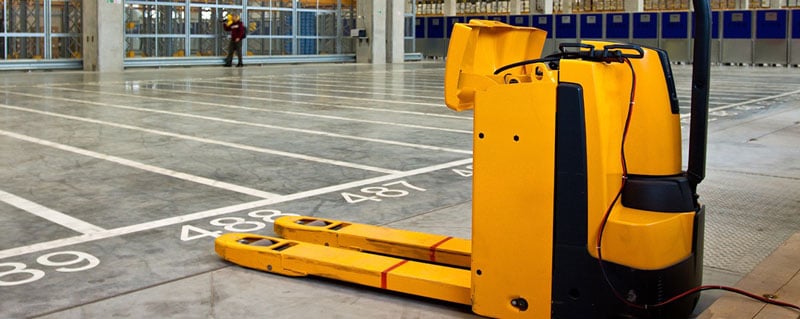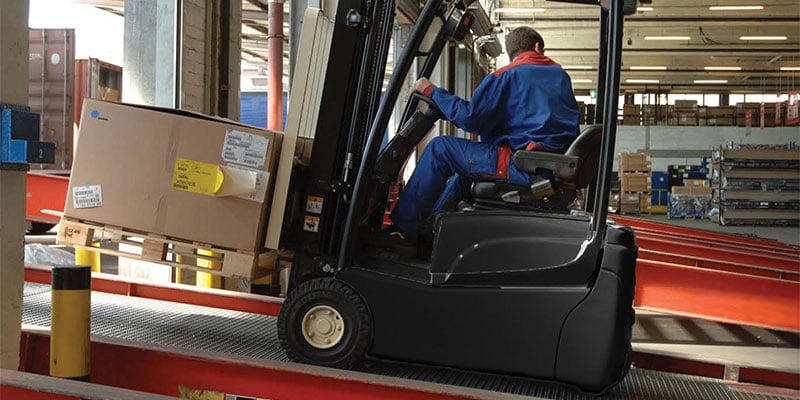Batteries helped the Lunar Roving Vehicle explore the moon – and continue to power everything from trains and warehouse forklifts to golf carts, scissor lifts, and passenger vehicles.
Today, we’ll examine the evolution of EV batteries – from their early days to today and into the future.
Keep reading for a high-level overview of EV batteries and chargers, including:
- What all batteries have in common
- Electric vehicles throughout history
- Behind the Scenes: The Second Electric Revolution
- Why smart charging is critical – and how new chargers are transforming EV use
- Opportunity charging for speed and profit
- And more
Battery Basics
Batteries have been around for hundreds of years and share an underlying concept:
- Chemical potential energy is housed inside the battery.
- Then, a chemical reaction releases this energy, creating electricity.
And whether your batteries are recyclable lead-acid (FLA) or absorbent glass mat (AGM) or lithium-ion (LI), lithium, lithium iron phosphate (LFP), or nickel metal hydride (NiMH)…
… they all have the following:
- Two electrical terminals called an anode and a cathode
- And a chemical between them, called electrolyte
DISCHARGING/USE: When ions travel through the electrolyte from the anode to the cathode, they output electricity.
RECHARGING: Reverse the direction of ion flow (i.e., from cathode to anode), and the battery recharges.
And since the beginning, scientists have been hard at work evolving batteries.
Powering electric vehicles (EVs) since the beginning
The early 1800s brought significant progress to energy storage.
In 1800, Alessandro Volta discovered that certain liquids generate a flow of continuous electrical power and that different metals have varying voltage potentials.
Volta’s work led to William Cruickshank's creation of the first mass-produced battery in 1802. Because these early batteries were not rechargeable, they weren’t practical for many of the applications we associate them with today.
A few decades later, the first electric carriages entered the market – much longer ago than we’d think of for an electric vehicle!
Similarly, electric trains first went public in 1837 with chemist Robert Davidson’s galvanic cell-powered locomotive.
The quantum leap was rechargeable batteries: In 1859, French physicist Gaston Planté solved this issue – and developed the first rechargeable lead-acid battery, the precursor to modern automotive batteries.
Camille Alphonse Faure later improved this design in 1881; his lead-grid lattice filled with lead oxide paste made the battery more powerful and easier to mass-produce.
A few decades later, electric vehicles had their first heyday in the passenger vehicle market.
Back in the early 1900s, it wasn’t clear which energy type would dominate the emerging auto industry – electricity or fossil fuels.
Britannica’s Christopher Foster and George Cromer explain:
“At the beginning of the 20th century, 40 percent of American automobiles were powered by steam, 38 percent by electricity, and 22 percent by gasoline.” (Source: Early electric automobiles, Encyclopaedia Britannica)
But limited battery charging infrastructure – and a limited electrical grid in general – slowed down the adoption of electric vehicles.
In addition, battery and car innovations also shifted the tide.
Ironically, many experts cite the starter battery as the nail in the coffin for early electric passenger vehicles. The electric self-starter ended hand cranking and made internal combustion engines easy to start – and that, combined with charging times and early versions of lead-acid batteries, limited market share.
The Second Electric Revolution
Batteries have played a key role in industry and commercial applications for decades, including in forklifts, scissor lifts, golf courses, and trains.
Electric gasoline hybrids gave the public a taste of EVs, including improved efficiency (miles per gallon or kilometers per liter) without range anxiety. Many models have featured AGM and NiMH batteries.
And many internal combustion vehicles feature absorbent glass mat (AGM) batteries for their start-stop engine systems, which improve fuel efficiency by shutting down the engine when the vehicle stops.
For fully electric passenger cars, battery technologies like LI and LFP and expanded charging infrastructure enabled widespread EV adoption.
That, combined with environmental concerns and subsidies (once reserved primarily for fossil fuels), has led to the fast adoption of battery-powered transportation.
Enough has been written about various fully electric car batteries to fill entire books.
Because passenger EVs come prepackaged with particular batteries, we’ll look ahead to Industrial EVs and charging innovations.
In industrial applications, recyclable lead-acid and AGM batteries still dominate because they’re:
- Reliable with over 100 years of innovation and safe use
- 99% recycled – more than aluminum cans
- High-ROI, often with the lowest cost per watt-hour
- Able to deliver high-discharge currents
- Safer because they’re far less likely to enter “thermal runaway”
Smart charging innovations are critical for ROI, safety, and lifespan
Today’s latest chargers are faster and use less energy. And because they’re computer-controlled, your batteries may last longer and charge more deeply and safer.
If you drive an electric car, you probably already have an intelligent charger installed at home – or use public smart chargers.
But if you use electric vehicles at work – such as forklifts or floor scrubbers…
… then recent charging innovations can save you time, money, and hassles.
Of course, the best charger is the one that matches your battery technology, ROI and up-front budget requirements, and charging speed needs.
Here are common options:
- Smart (“opportunity”) and High-Frequency chargers can provide the longest life and greatest capacity. That’s because they constantly track the state of charge, temperature, and more. These chargers don’t overcharge batteries, so they often slash electric bills and boost ROI for many years. Smart chargers can improve capacity and reduce heat-related damage, even collecting data.
- Silicon-controlled rectifier chargers (SCR) are a cost-effective, multi-voltage option that works well with flooded and AGM batteries.
- Ferroresonant chargers offer the lowest up-front costs, along with high reliability and low maintenance. However, they cannot monitor charge levels or compensate for battery temperature and other variables. Thus, batteries may overcharge to ~110%. Overcharging leads to overheating – which means decreased performance, shortened life, and wasted electricity. Ferroresonant’s long-term cost is often higher than newer technologies.
Read our “Forklift Battery Charging Innovations that Improve Warehouse Operations to learn more strategies to boost battery life and uptime.
Opportunity charging is transforming industrial battery use
For over 70 years, companies used three batteries on three shifts - running for eight hours, charging for eight hours, and cooling for eight hours.
Now, many operations are using one truck, one battery, and one charger to save energy costs, reduce their battery count, and increase their return on investment.
This isn’t just popular in warehouses, either; opportunity charging is becoming increasingly common for electric cars, with charging stations being installed at grocery stores, gas/electricity stations, and in homes.
Both conventional and opportunity charging use the same underlying principles – but they vary greatly in their approaches and efficiency.
Conventional charging
Batteries are sensitive to extreme overcharging and temperatures. Traditional charging methods overcharge batteries in a process that takes additional time, wastes electricity, and results in high battery temperature – and shorter service life.
Opportunity charging
Rapid charging charges the battery from 20% to 80% in two hours or less. Opportunity charging maintains a battery’s state of charge between 30% and 80% during a typical work shift.
Opportunity rapid charging allows batteries to charge faster and at higher rates – during breaks, lunches, after shifts, and anytime they can charge for at least ten minutes. Once a day, the battery is recharged to 100% of its rated capacity. On weekends, chargers automatically equalize batteries.
Whatever EV batteries you choose, innovations start in the laboratory and the manufacturing plant
All battery types benefit from sweeping innovations in R&D and manufacturing – and that’s improving lifespan, reliability, and performance.
From early assembly lines and new chemistry lab equipment to computer-aided design, today’s batteries are leaps ahead of models from the last century.
But as William Gibson said:
“The future is already here – it’s just not evenly distributed yet.”
Some battery manufacturers use older engineering, assembly, and quality control equipment, processes, and methodologies – because they’re more accessible, don’t require retooling, and are less glamorous than investing in marketing campaigns.
By contrast, Crown Battery uses the latest 3D R&D and manufacturing technologies – along with proprietary design and manufacturing processes. For instance:
- Our engineers use 3D modeling, 3D measurement, and 3D printing to increase accuracy and throughput.
- Our batteries are 99% recyclable – and use roughly 80% recycled materials – for a lower carbon footprint and less waste.
- Trained technicians supervise robotic assembly equipment, enhancing reliability, consistency, and performance.
- Batteries undergo a 250+ point quality control inspection.
- Proprietary Cast-On-Strap (COS) welding allows for 3,960 more adjustments than conventional welding – improving performance and eliminating common failure points such as cold spots during welding.
What’s next
At Crown Battery and worldwide, scientists and researchers continue to innovate new battery types and improve existing battery chemistries. They enhance power density and sustainability, bolster safety, and minimize waste.
And Crown is actively working to close the Battery Recycling Gap – and ensure Universal Battery Recycling.
But you don’t need to wait decades for the next battery innovations.












